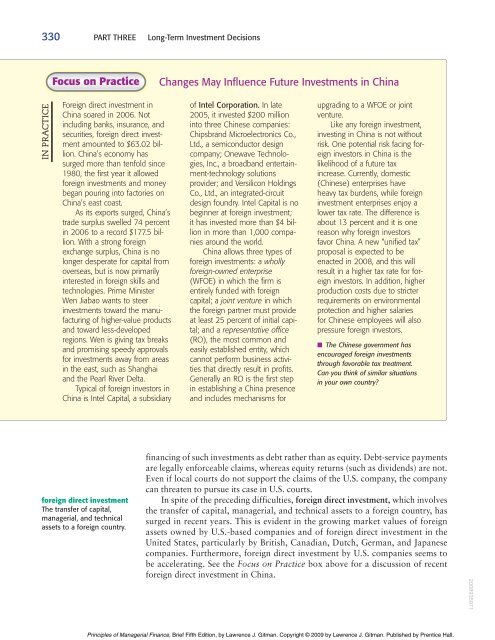Chapter 8 - Pearson Learning Solutions
Chapter 8 - Pearson Learning Solutions
Chapter 8 - Pearson Learning Solutions
You also want an ePaper? Increase the reach of your titles
YUMPU automatically turns print PDFs into web optimized ePapers that Google loves.
330 PART THREE Long-Term Investment DecisionsFocus on PracticeChanges May Influence Future Investments in ChinaIN PRACTICEForeign direct investment inChina soared in 2006. Notincluding banks, insurance, andsecurities, foreign direct investmentamounted to $63.02 billion.China’s economy hassurged more than tenfold since1980, the first year it allowedforeign investments and moneybegan pouring into factories onChina’s east coast.As its exports surged, China’strade surplus swelled 74 percentin 2006 to a record $177.5 billion.With a strong foreignexchange surplus, China is nolonger desperate for capital fromoverseas, but is now primarilyinterested in foreign skills andtechnologies. Prime MinisterWen Jiabao wants to steerinvestments toward the manufacturingof higher-value productsand toward less-developedregions. Wen is giving tax breaksand promising speedy approvalsfor investments away from areasin the east, such as Shanghaiand the Pearl River Delta.Typical of foreign investors inChina is Intel Capital, a subsidiaryof Intel Corporation. In late2005, it invested $200 millioninto three Chinese companies:Chipsbrand Microelectronics Co.,Ltd., a semiconductor designcompany; Onewave Technologies,Inc., a broadband entertainment-technologysolutionsprovider; and Versilicon HoldingsCo., Ltd., an integrated-circuitdesign foundry. Intel Capital is nobeginner at foreign investment;it has invested more than $4 billionin more than 1,000 companiesaround the world.China allows three types offoreign investments: a whollyforeign-owned enterprise(WFOE) in which the firm isentirely funded with foreigncapital; a joint venture in whichthe foreign partner must provideat least 25 percent of initial capital;and a representative office(RO), the most common andeasily established entity, whichcannot perform business activitiesthat directly result in profits.Generally an RO is the first stepin establishing a China presenceand includes mechanisms forupgrading to a WFOE or jointventure.Like any foreign investment,investing in China is not withoutrisk. One potential risk facing foreigninvestors in China is thelikelihood of a future taxincrease. Currently, domestic(Chinese) enterprises haveheavy tax burdens, while foreigninvestment enterprises enjoy alower tax rate. The difference isabout 13 percent and it is onereason why foreign investorsfavor China. A new “unified tax”proposal is expected to beenacted in 2008, and this willresult in a higher tax rate for foreigninvestors. In addition, higherproduction costs due to stricterrequirements on environmentalprotection and higher salariesfor Chinese employees will alsopressure foreign investors.■ The Chinese government hasencouraged foreign investmentsthrough favorable tax treatment.Can you think of similar situationsin your own country?foreign direct investmentThe transfer of capital,managerial, and technicalassets to a foreign country.financing of such investments as debt rather than as equity. Debt-service paymentsare legally enforceable claims, whereas equity returns (such as dividends) are not.Even if local courts do not support the claims of the U.S. company, the companycan threaten to pursue its case in U.S. courts.In spite of the preceding difficulties, foreign direct investment, which involvesthe transfer of capital, managerial, and technical assets to a foreign country, hassurged in recent years. This is evident in the growing market values of foreignassets owned by U.S.-based companies and of foreign direct investment in theUnited States, particularly by British, Canadian, Dutch, German, and Japanesecompanies. Furthermore, foreign direct investment by U.S. companies seems tobe accelerating. See the Focus on Practice box above for a discussion of recentforeign direct investment in China.2008935971Principles of Managerial Finance, Brief Fifth Edition, by Lawrence J. Gitman. Copyright © 2009 by Lawrence J. Gitman. Published by Prentice Hall.

















